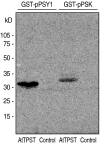Identification of tyrosylprotein sulfotransferase in Arabidopsis
- PMID: 19666544
- PMCID: PMC2736448
- DOI: 10.1073/pnas.0902801106
Identification of tyrosylprotein sulfotransferase in Arabidopsis
Abstract
Tyrosine sulfation is a posttranslational modification common in peptides and proteins synthesized by the secretory pathway in most eukaryotes. In plants, this modification is critical for the biological activities of a subset of peptide hormones such as PSK and PSY1. In animals, tyrosine sulfation is catalyzed by Golgi-localized type II transmembrane proteins called tyrosylprotein sulfotransferases (TPSTs). However, no orthologs of animal TPST genes have been found in plants, suggesting that plants have evolved plant-specific TPSTs structurally distinct from their animal counterparts. To investigate the mechanisms of tyrosine sulfation in plants, we purified TPST activity from microsomal fractions of Arabidopsis MM2d cells, and identified a 62-kDa protein that specifically interacts with the sulfation motif of PSY1 precursor peptide. This protein is a 500-aa type I transmembrane protein that shows no sequence similarity to animal TPSTs. A recombinant version of this protein expressed in yeast catalyzed tyrosine sulfation of both PSY1 and PSK precursor polypeptide in vitro, indicating that the newly identified protein is indeed an Arabidopsis (At)TPST. AtTPST is expressed throughout the plant body, and the highest levels of expression are in the root apical meristem. A loss-of-function mutant of AtTPST displayed a marked dwarf phenotype accompanied by stunted roots, pale green leaves, reduction in higher order veins, early senescence, and a reduced number of flowers and siliques. Our results indicate that plants and animals independently acquired tyrosine sulfation enzymes through convergent evolution.
Conflict of interest statement
The authors declare no conflict of interest.
Figures




Comment in
-
Protein tyrosine sulfation: a critical posttranslation modification in plants and animals.Proc Natl Acad Sci U S A. 2009 Sep 1;106(35):14741-2. doi: 10.1073/pnas.0908376106. Epub 2009 Aug 26. Proc Natl Acad Sci U S A. 2009. PMID: 19717448 Free PMC article. No abstract available.
Similar articles
-
Tyrosylprotein Sulfotransferase Positively Regulates Symbiotic Nodulation and Root Growth.Plant Cell Environ. 2025 Jan;48(1):553-570. doi: 10.1111/pce.15154. Epub 2024 Sep 17. Plant Cell Environ. 2025. PMID: 39286964
-
Existence of a plant tyrosylprotein sulfotransferase: novel plant enzyme catalyzing tyrosine O-sulfation of preprophytosulfokine variants in vitro.FEBS Lett. 2000 Mar 24;470(2):97-101. doi: 10.1016/s0014-5793(00)01299-0. FEBS Lett. 2000. PMID: 10734215
-
Molecular cloning and expression of human and mouse tyrosylprotein sulfotransferase-2 and a tyrosylprotein sulfotransferase homologue in Caenorhabditis elegans.J Biol Chem. 1998 Sep 18;273(38):24770-4. doi: 10.1074/jbc.273.38.24770. J Biol Chem. 1998. PMID: 9733778
-
Determinants of tyrosylprotein sulfation coding and substrate specificity of tyrosylprotein sulfotransferases in metazoans.Chem Biol Interact. 2016 Nov 25;259(Pt A):17-22. doi: 10.1016/j.cbi.2016.04.006. Epub 2016 Apr 7. Chem Biol Interact. 2016. PMID: 27062897 Review.
-
Protein tyrosine sulfation, 1993--an update.Chem Biol Interact. 1994 Jun;92(1-3):257-71. doi: 10.1016/0009-2797(94)90068-x. Chem Biol Interact. 1994. PMID: 8033259 Review.
Cited by
-
Holophytochrome-Interacting Proteins in Physcomitrella: Putative Actors in Phytochrome Cytoplasmic Signaling.Front Plant Sci. 2016 May 12;7:613. doi: 10.3389/fpls.2016.00613. eCollection 2016. Front Plant Sci. 2016. PMID: 27242820 Free PMC article.
-
Fine-mapping of a major QTL controlling plant height by BSA-seq and transcriptome sequencing in cotton.Theor Appl Genet. 2024 Sep 9;137(10):217. doi: 10.1007/s00122-024-04714-w. Theor Appl Genet. 2024. PMID: 39249496
-
Q&A: How does peptide signaling direct plant development?BMC Biol. 2016 Jul 8;14:58. doi: 10.1186/s12915-016-0280-3. BMC Biol. 2016. PMID: 27392694 Free PMC article.
-
Spatiotemporal signalling in plant development.Nat Rev Genet. 2013 Sep;14(9):631-44. doi: 10.1038/nrg3541. Nat Rev Genet. 2013. PMID: 23949543 Free PMC article. Review.
-
Expression of a novel PSK-encoding gene from soybean improves seed growth and yield in transgenic plants.Planta. 2019 Apr;249(4):1239-1250. doi: 10.1007/s00425-019-03101-w. Epub 2019 Feb 12. Planta. 2019. PMID: 30756185
References
Publication types
MeSH terms
Substances
LinkOut - more resources
Full Text Sources
Other Literature Sources
Molecular Biology Databases
Miscellaneous

